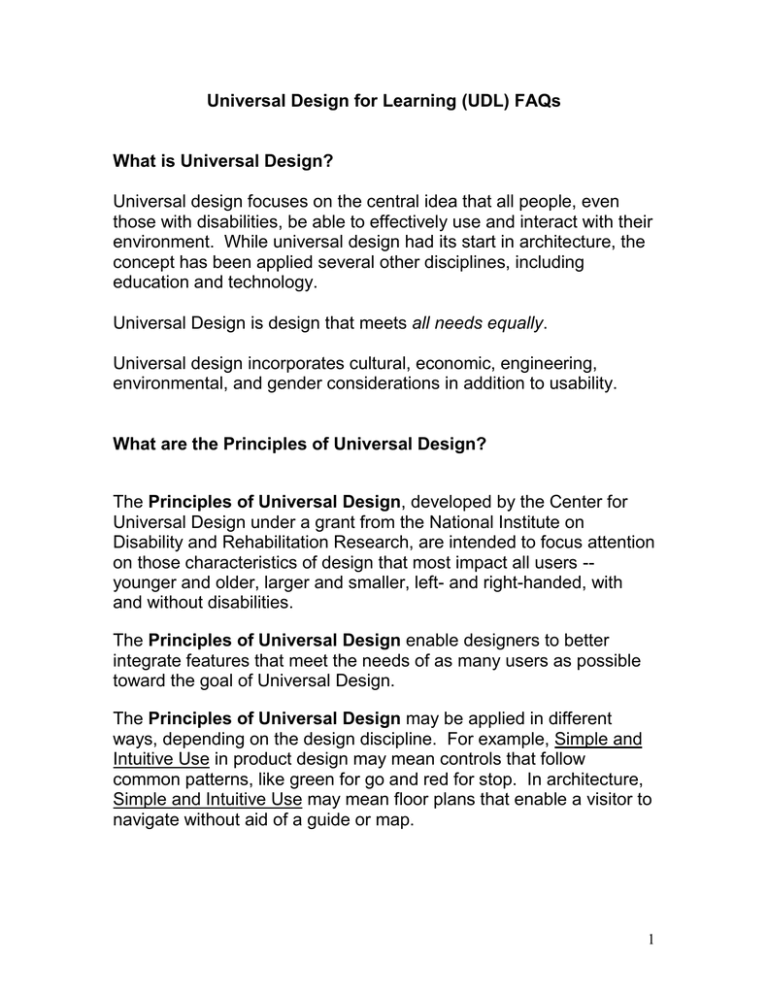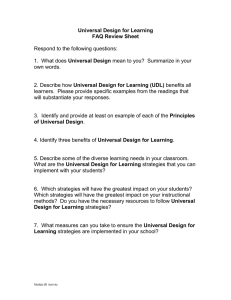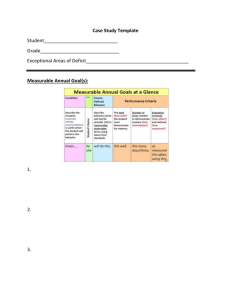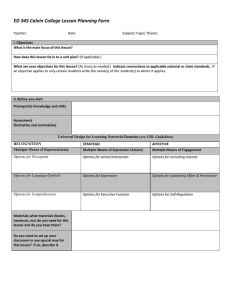Universal Design for Learning FAQs
advertisement

Universal Design for Learning (UDL) FAQs What is Universal Design? Universal design focuses on the central idea that all people, even those with disabilities, be able to effectively use and interact with their environment. While universal design had its start in architecture, the concept has been applied several other disciplines, including education and technology. Universal Design is design that meets all needs equally. Universal design incorporates cultural, economic, engineering, environmental, and gender considerations in addition to usability. What are the Principles of Universal Design? The Principles of Universal Design, developed by the Center for Universal Design under a grant from the National Institute on Disability and Rehabilitation Research, are intended to focus attention on those characteristics of design that most impact all users -younger and older, larger and smaller, left- and right-handed, with and without disabilities. The Principles of Universal Design enable designers to better integrate features that meet the needs of as many users as possible toward the goal of Universal Design. The Principles of Universal Design may be applied in different ways, depending on the design discipline. For example, Simple and Intuitive Use in product design may mean controls that follow common patterns, like green for go and red for stop. In architecture, Simple and Intuitive Use may mean floor plans that enable a visitor to navigate without aid of a guide or map. 1 Equitable Use The design does not disadvantage or stigmatize any group of users. Flexibility in Use The design accommodates a wide range of individual preferences and abilities. Simple and Intuitive Use Use of the design is easy to understand, regardless of the user's experience, knowledge, language skills, or current concentration level. Perceptible Information The design communicates necessary information effectively to the user, regardless of ambient conditions or the user's sensory abilities. Tolerance for Error The design minimizes hazards and the adverse consequences of accidental or unintended fatigue. Low Physical Effort The design can be used efficiently and comfortably and with a minimum of fatigue. Size and Space for Approach and Use Appropriate size and space is provided for approach, reach, manipulation, and use, regardless of the user's body size, posture, or mobility What is Universal Design for Learning (UDL)? UDL focuses on the ability of teachers to meet the diverse learning needs of all students, even those with impairments that affect their mobility, vision, hearing, and learning. Teachers must recognize that there are multiple and flexible ways of providing effective instruction while adhering to curricular standards and objectives. Thanks to technology, universal design enables students to respond to and interact with curricula and achieve learning standards. 2 What are the benefits of UDL? UDL embeds accessible features into curriculum design from the beginning; it is “proactive”, like having built-in accommodations that provide immediate accessibility for all students. UDL inherently provides multiple (alternative) and flexible instructional methodologies to ensure that all students can access, participate in, and progress in the curriculum. UDL meets the diverse learning needs of all students. UDL correspond to the concepts of differentiated instruction (DI); that there are four classroom elements that should be taken into account to ensure differentiated instruction: content, process, product, and learning environment.” Both seek to enhance student achievement by proactively designing learning environments and instructional materials in ways that allow all students to be successful (DeCoste). What is the difference between UDL and Assistive Technology? Assistive technology (AT) devices and services are considered by the individualized education plan (IEP) team. AT strategies are developed for the individual student whereas UDL benefits all students. What is the difference between UDL and Accommodations? Appropriate instructional accommodations do not change curriculum content and standards or decrease content difficulty. Teachers provide accommodations to students with disabilities as add-ons to the standard curriculum materials and methods. UDL embeds accommodations, or “front-loads” them and integrates them into the overall design of curriculum instruction. 3 What makes UDL solutions possible? Digital technology makes UDL curriculum solutions possible. For example, digitized textbooks enable students to take responsibility for their own learning by allowing them to highlight words, enlarge text type, increase the volume, use links to look up unfamiliar words, just to name a few. Teachers can easily infuse digitized text into their instructional methods and other classroom technologies; scanning text becomes obsolete. Technology offers the flexibility “upfront” that is needed when addressing students’ diverse learning needs. A teacher’s first step in adopting a UDL framework in the classroom is to assess and identify the students’ diverse learning needs. See Universal Design for Learning: Planning Solutions example and blank template. UDL Websites http://www.adaptiveenvironments.org/universal/imagesofud.php?f=7 http://www.design.ncsu.edu/cud/univ_design/princ_overview.htm http://www.ap.buffalo.edu/idea/ubdweb/page1.htm http://udeducation.org/resources/index.asp 4



